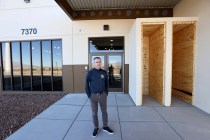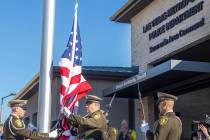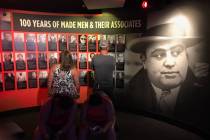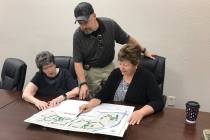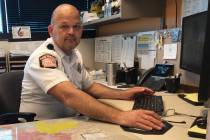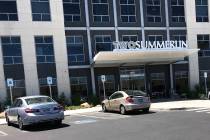Permit-less public street shutdown has penalties
We exited the 215 Beltway onto West Cheyenne Avenue with the expectation of moving into the right lane, heading east. That’s the lane used to bypass most traffic lights, the lane that allows vehicles steady movement.
Big mistake. Orange road cones blocked off the entire right lane for as far as the eye could see.
So instead of three lanes, only two were open. And traffic was building, especially as we approached traffic light intersections. Our frustration level also was building as we slowed down from one traffic light to another while trying to figure out why on earth the drive-through lane was blocked off.
The distance on Cheyenne from the Beltway exit to Rampart Boulevard is 2.7 miles. So, for 2.7 miles, we moved along in traffic that had been building while we saw lots of orange cones blocking a lane that was specifically designed to reduce traffic.
But the clincher was this: We saw nothing — absolutely nothing — happening in that third lane to have warranted its shutdown. Once we passed the Rampart intersection, we were in the midst of roadwork involving the installation of sewer pipes on Cheyenne. But that was 2.7 miles away. Furthermore, that was not the reason why the right lane had been closed.
“There was work scheduled to be done on a wall just beyond the shoulder of the road,” explained Jerry Walker, the deputy operations and maintenance director for the city of Las Vegas. Work on the wall along the 2.7-mile sector was to be of a cosmetic nature, only none of that was going on at the time we drove by.
“That lane shutdown should not have happened. It annoys me when things like that happen. I would have felt the same frustration,” Walker commented.
On another recent occasion, we were driving east on Lake Mead Boulevard. When we came to the intersection at Del Webb Boulevard and Lake Mead, there were those orange road cones again, closing off the right lane. The lane was shut for 1.1 miles, until we reached the intersection at Lake Mead and Rampart.
Once again, nothing was happening, nor was there any indication of activity for the full length of the 1.1 miles. Of course, motorists who drove along that stretch and observed the lack of activity might easily have become irritated.
So why do these things happen? Who are these people who close off roads? Aren’t there laws, regulations and standards that prohibit the idling of lanes on city roads?
There are answers, indeed, and there are fines for those who do not comply with the laws, regulations and standards. And in some cases, those responsible for closing off lanes — whether they be contractors, landscapers, utilities or whoever — could face misdemeanor charges due to laxity, explained Mike Janssen, deputy director/transportation manager in the city’s Public Works Department.
“For one thing, under our municipal code, it’s illegal for anyone to place cones on public streets without a permit. We have two traffic control barricade inspectors who drive around the city to see to it that cones and other traffic control devices, such as arrow boards and signs, are being used legally and properly,” Janssen said.
The municipal code was drawn from extensive federal and state road safety manuals, and in a “typical year,” the city processes between 3,500 and 4,000 permits for lane closures, he explained. Permits are granted on the basis of commitments of strict compliance by applicants who must provide location, closure dates, number of hours of closure and a variety of other data.
“Actual work is usually done by a general contractor, who first hires a subcontractor to put down the cones and set up the signs and arrow boards,” said Janssen. “But sometimes we run into a ‘ghost zone.’ ” That’s a situation where something occurs that prevents the contractor from fulfilling his obligation after cones and other traffic control devices have been deployed.
“That could cost the contractor thousands of dollars,” said Janssen, both in wasted work by the subcontractor and in noncompliance fines resulting from lane closures. He said that such fines are actually “lane rental fees,” adding that those situations occur weekly.
Herb Jaffe was an op-ed columnist and investigative reporter for most of his 39 years at the Star-Ledger of Newark, N.J. His most recent novel, “Double Play,” is now available. Contact him at hjaffe@cox.net.








